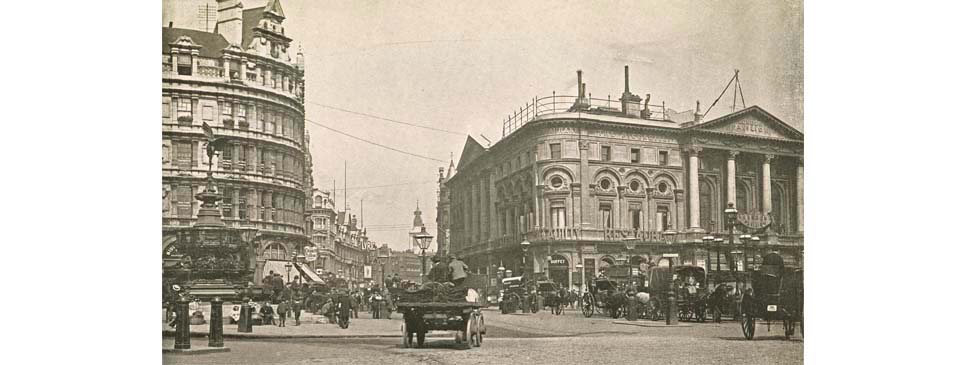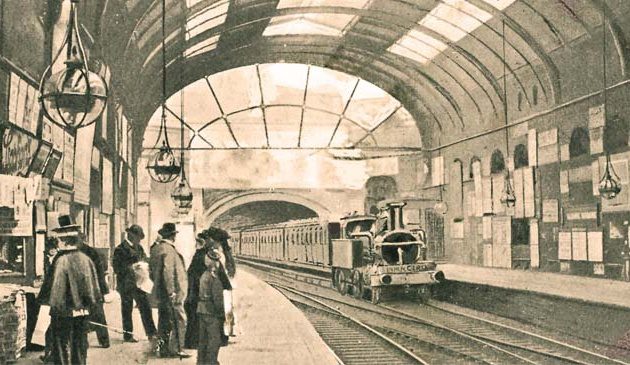In brief – Late-Victorian London

Piccadilly Circus at the end of the 19th century. We see along Shaftesbury Avenue, which was laid out in 1886 from here to Cambridge Circus and on to New Oxford Street. At the same time, the former London Pavilion music hall, seen on the right, was rebuilt and enlarged as a grand variety theatre. On the left is the Shaftesbury Memorial Fountain, erected in 1892-3 and topped by Anteros, but normally mistakenly known as ‘Eros’. Both the fountain and street are named after the philanthropist, the 7th Earl of Shaftesbury.
Despite a rapid increase in the population, crime fell in the second half of the century, as London became a more modern and prosperous city and policing became a more efficient organization. The Metropolitan Police moved to their New Scotland Yard headquarters on the Embankment in 1890. Public hangings, which had long been a great London spectacle, ended with that of the Fenian Michael Barrett in 1868 and thereafter took place behind closed doors. The many small and ancient gaols in the City, Southwark and Westminster were gradually closed, replaced by much larger institutions at what were then the edges of the metropolis.
The most notorious crimes of the 19th century are the series of gruesome murders of prostitutes that took place around Whitechapel between April 1888 and February 1891. A letter sent to the Central News Agency and signed by ‘Jack the Ripper’ ensured that they made headlines around the world. Despite an intensive investigation and much speculation as to the perpetrator the crimes have never been solved.
In 1861 there was a disastrous fire at a Thameside warehouse in Tooley Street. Despite the efforts of the fire services the blaze continued to burn for two days, causing much damage. Worse still, James Braidwood, founder and leader of the London Fire Engine Establishment, was killed. The fire insurance companies who funded the LFE informed the government they were no longer able to continue to take responsibility and in 1866 the Metropolitan Fire Brigade came into being.
Some of the responsibilities of managing London’s infrastructure, such as sewers, roads and some bridges were handed to the newly-formed Metropolitan Board of Works from 1855. The MBW did not solve all London’s problems but they had some notable successes. However, by the 1880s corruption had become ingrained within the organization. In 1888 the government created directly elected councils throughout the country. For the first time, London became a county, enlarged by absorbing parts of Middlesex, Essex, Kent and Surrey. Shortly after the creation of the County of London it was sub-divided into twenty-eight metropolitan boroughs, each responsible for their own district from 1900. The City was given the status of ‘borough within a county’, with a large amount of independence. The newly-formed London County Council was given wide-ranging responsibilities, including those of the MBW, which was immediately disbanded.
London’s streets became brighter at night throughout the century as gas lighting was gradually installed throughout the capital. Gasworks, with their large storage holders, became a common sight. In 1883 the American engineer Thomas Edison established an electricity power station in a basement at Holborn Viaduct to provide a supply to the Old Bailey and the General Post Office and by 1900 London had two hundred miles of streets illuminated by electricity. The introduction of electricity was followed by a number of new inventions using the energy, including Gugliemo Marconi’s wireless radio, which he demonstrated in London in July 1896. The first telephone exchange in London was opened in Coleman Street in 1879 with a small number of subscribers. After two years, the system had grown to almost one thousand users and fifty exchanges and it was soon possible to telephone between other parts of the country.
A significant change in ship-building took place in the second half of the century, with much larger vessels built of iron and powered by steam. London responded by creating even larger docks. The Royal Victoria Dock opened in 1855, followed by the adjoining Royal Albert Dock in 1880. As ships became even bigger the East & West India Dock Company opened a new deep-water port much further downriver at Tilbury in 1886 with a rail connection to Fenchurch Street in the City. The majority of the tens of thousands of dockers were casual labourers or occasional workers. Large crowds of them waited at the dock and wharf gates each morning hoping to be picked for a day’s work by the foremen.


